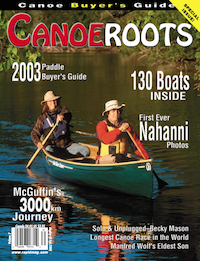Hiding behind my truck’s lowered tailgate and pretending to be tying my shoes, I watched in utter amazement as Rich slowly reached into the Thule box above his ’84 Volvo wagon and lifted out a 58-inch, multi-coloured wool stocking. He undid the red ribbon tied neatly in a bow around the woolly sheath and reached inside to draw his cherry ottertail sword. Sir Lancelot ran his finger- tips down the blade, gingerly like he was touching the face of a lover before engaging her in a romantic kiss. He held it above his head looking up his arm and along the shaft. Sun glistened off the tip. What the hell was this guy doing with his paddle?
While he folded his specially knit paddle cozy I thought about my paddle’s trip to the river. Tossed in the back of my pickup like a carpenter’s hammer, it rattled and shook off the last of its varnish. It lay next to the spare gas can covered in 67 kilometres of late-summer logging-road dust. Once they were on the water our paddles would be equal, but Rich clearly held his Excalibur in a higher place.
Paddles are hung above mantels in cottages, rested against desks in university dorm rooms and displayed in homes in prominent places once reserved for straight-faced portraits of ancestors. Miniature canoe paddles are crafted into coat racks and I’m sure paddles are the most popular canvas for aspiring wood carvers and painters of snowy chickadee scenes. Putting together the new Paddle Buyer’s Guide for the Summer 2003 of Canoeroots, I wondered how the paddle became a symbol worthy of a spot on the livingroom wall or a knitted carrying case.
NOT JUST TOOLS TO GET DOWN THE RIVER
I called Jeremy Ward at the Canadian Canoe Museum and asked him whether the voyageurs lovingly cherished their paddles. Jeremy said nobody’s entirely sure, but he suspects that the men who opened the country didn’t knit themselves paddle socks. In official documents and journals, references to paddles are conspicuously missing. When a new voyageur signed on with the Northwest Company he was issued blankets, tumpline, sometimes clothing and often an advance on his wages.The equipment inventories contain no mention of paddles. It seems that François, Amable, Joseph and the boys had to supply their own paddles and in those days that meant making their own. Likely, paddles were chopped from a nearby tree, another chore in the daily 15-hour grind of moving furs. Jeremy and I agreed that tracing the origin of paddle nostalgia was worthy of a larger study, a doctoral thesis perhaps.
Canoe paddles are not only tools to propel us across lakes and down rivers. Hanging on walls they float us on memories—summer camp, grandmother’s cottage or a campsite shared with a close friend.
In university a friend of mine designed a simple tattoo with two paddles crossed, like the bats on a little league baseball cap, and under the crossed paddles were three words. I don’t know if he ever got the tattoo, but the words are burned into the hearts of every canoeist who hangs her paddle on the wall or carries his paddle in a sheath:
Swords of Freedom.
 This article first appeared in the Summer 2003 issue of Canoeroots Magazine. For more great content, subscribe to Canoeroots’ print and digital editions here.
This article first appeared in the Summer 2003 issue of Canoeroots Magazine. For more great content, subscribe to Canoeroots’ print and digital editions here.



